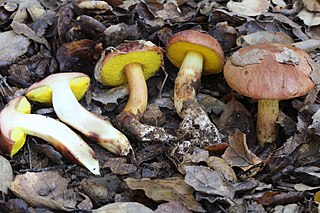
Aureoboletus is a genus of bolete fungi in the family Boletaceae. It was circumscribed by Czech mycologist Zdeněk Pouzar in 1957. A taxonomic monograph was published in 2010 by Wolfgang Klofac.

Boletellus is a genus of fungi in the family Boletaceae. The genus has a widespread distribution, especially in subtropical regions, and contains about 50 species. The genus was first described by American mycologist William Alphonso Murrill in 1909. The genus name means "small Boletus".

Boletellus obscurecoccineus, known as the rhubarb bolete, is a species of fungus in the family Boletaceae, found in Australia, New Guinea, Java, Borneo, Japan, Korea, and Taiwan. It is a distinctive and colourful bolete of the forest floor.

Aureoboletus mirabilis, commonly known as the admirable bolete, the bragger's bolete, and the velvet top, is an edible species of fungus in the Boletaceae mushroom family. The fruit body has several characteristics with which it may be identified: a dark reddish-brown cap; yellow to greenish-yellow pores on the undersurface of the cap; and a reddish-brown stem with long narrow reticulations. Aureoboletus mirabilis is found in coniferous forests along the Pacific Coast of North America, and in Asia. Unusual for boletes, A. mirabilis sometimes appears to fruit on the wood or woody debris of Hemlock trees, suggesting a saprobic lifestyle. Despite the occasional appearances to the contrary, Aureoboletus mirabilis is mycorrhizal, and forms a close association with the tree's roots.

Xerocomellus zelleri, commonly known as Zeller's bolete, is an edible species of mushroom in the family Boletaceae. First described scientifically by American mycologist William Alphonso Murrill in 1912, the species has been juggled by various authors to several genera, including Boletus, Boletellus, and Xerocomus. Found solely in western North America from British Columbia south to Mexico, the fruit bodies are distinguished by their dark reddish brown to nearly black caps with uneven surfaces, the yellow pores on the underside of the caps, and the red-streaked yellow stems. The fungus grows in summer and autumn on the ground, often in Douglas fir forests or on their margins. The development of the fruit bodies is gymnocarpic, meaning that the hymenium appears and develops to maturity in an exposed state, not enclosed by any protective membrane.

Boletellus ananas, commonly known as the pineapple bolete, is a mushroom in the family Boletaceae, and the type species of the genus Boletellus. It is distributed in southeastern North America, northeastern South America, Asia, and New Zealand, where it grows scattered or in groups on the ground, often at the base of oak and pine trees. The fruit body is characterized by the reddish-pink scales on the cap that are often found hanging from the edge. The pore surface on the underside of the cap is made of irregular or angular pores up to 2 mm wide that bruise a blue color. It is yellow when young but ages to a deep olive-brown color. Microscopically, B. ananas is distinguished by large spores with cross striae on the ridges and spirally encrusted hyphae in the marginal appendiculae and flesh of the stem. Previously known as Boletus ananas and Boletus coccinea, the species was given its current name by William Alphonso Murrill in 1909. Two varieties of Boletellus ananas have been described. Like many other boletes, this species is considered edible, but it is not recommended for consumption.

Boletellus singeri is a species of fungus in the family Boletaceae. It is known from Mexico, where it was collected from Sierra Nanchititla in the municipality of Tejupilco. The species is named after American mycologist Rolf Singer.
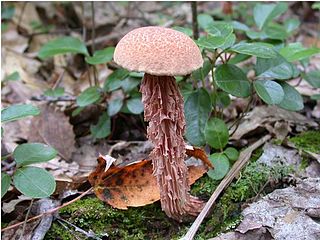
Aureoboletus russellii, commonly known as the Russell's bolete, or jagged-stemmed bolete, is a species of bolete fungus in the family Boletaceae. An edible species, it is found in Asia and eastern North America, where it grows in a mycorrhizal association with oak, hemlock, and pine trees. Fruit bodies of the fungus are characterized by their coarsely shaggy stem. The yellow-brown to reddish-brown caps are initially velvety, but become cracked into patches with age.

Boletellus jalapensis is a species of fungus in the family Boletaceae. Originally described under the name Ceriomyces jalapensis by William Alphonso Murrill in 1910, it was transferred to the genus Boletellus in 1931. It is known from Mexico and Costa Rica.

Boletellus chrysenteroides is a species of fungus in the family Boletaceae. It was first described as Boletus chrysenteroides by mycologist Wally Snell in 1936. Snell later (1941) transferred the species to Boletellus.

Boletellus dissiliens is a species of fungus in the family Boletaceae. Found in Singapore, it was originally described as Boletus dissiliens by E.J.H. Corner in 1972, and transferred to Boletellus in 1981.
Boletellus piakaii is a species of fungus in the family Boletaceae. It was found in Guyana and described in 2008.
Boletellus exiguus is a species of bolete fungus in the family Boletaceae. Found in the tropical forests of western Guyana, it was reported as new to science in 2008. The specific epithet exiguus derives from the Latin word for "small", referring to the small basidiocarps.

Boletellus emodensis, commonly known as the shaggy cap, is a species of fungus in the family Boletaceae. It was described by English mycologist Miles Joseph Berkeley in 1851 as Boletus emodensis, and transferred to Boletellus by Rolf Singer in 1942. Characterised by a distinctive reddish shaggy cap, it grows in eucalypt woodlands. It produces a brown spore print, and has fusiform (spindle-shaped) spores that are 16–20 by 7–9 μm with longitudinal grooves. It is similar in appearance to Boletellus ananiceps, but the latter species is scaly rather than shaggy, has a pinkish tint, and lacks grooves in the spores.
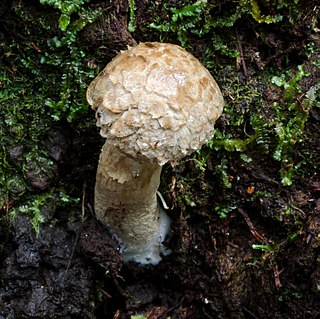
Boletellus ananaeceps is a species of fungus in the family Boletaceae. First described by Miles Joseph Berkeley under the name Boletus ananaeceps in 1873, it was transferred to Boletellus in 1955 by Rolf Singer. It is found in Australia.
Boletellus belizensis is a species of bolete fungus in the family Boletaceae. Found in Belize, it was described as new to science in 2007.
Boletellus domingensis is a species of bolete fungus in the family Boletaceae. Found in the Dominican Republic, it was described as new to science in 2007.
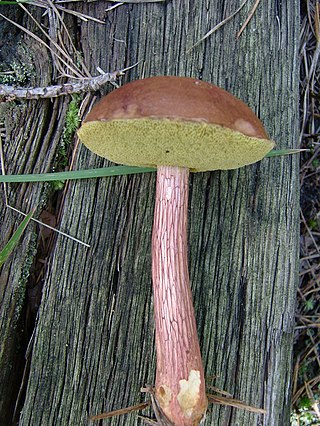
Aureoboletus projectellus is a species of bolete fungus in the family Boletaceae. Found in North America, and recently in Europe, it grows in a mycorrhizal association with pine trees.
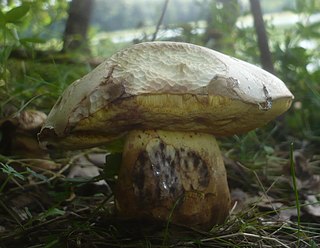
Caloboletus kluzakii is a bolete fungus native to Europe. Until 2014, it was known as Boletus kluzakii. Recent changes in the phylogenetic framework of the family Boletaceae prompted the transfer of this species, along with several other related boletes, including Caloboletus calopus, to the genus Caloboletus. It was described scientifically in 2006 by Josef Šutara and Pavel Špinar, from specimens collected in the Czech Republic. The fungus had earlier been published with the name Boletus fallax by Czech mycologist Zdeněk Kluzák in 1988, but this was invalid, as that name had been used previously by E.J.H. Corner for a Malaysian bolete. The epithet honours Kluzák's contributions in describing the species.














